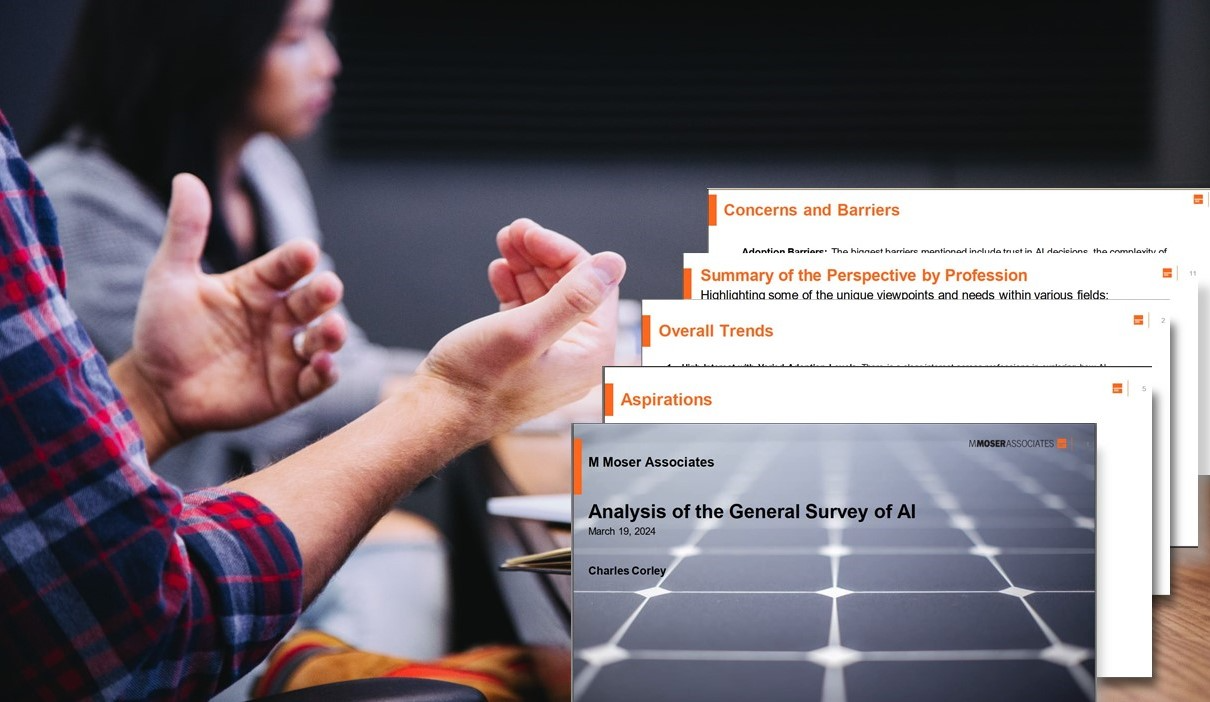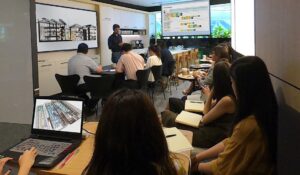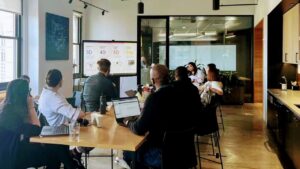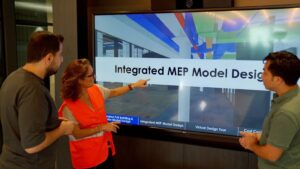In the first two chapters of this series we talked about the how and why we are adopting generative AI and how we formulated a team. But what next? We thought it would be best at this stage to take a step back and get to know our colleagues’ thoughts on the subject better. To that end, we recently conducted a comprehensive survey to gather insights from our diverse team. With nearly a thousand responses, we are learning about our colleagues’ hopes and concerns. This chapter focuses on getting to understand the needs and aspirations of the workforce early in the journey.
Our team is varied in their professional backgrounds, including strategy, project leadership, architecture, design, engineering, procurement, commercial management, construction management, sustainability, and wellness. They handle strategic development, documents, reports, data insights, visualizations, concept development, and articulation in personalized ways with different objectives. The architectural and workplace projects we design and deliver are unique bespoke solutions, with less standard procedure or full automation.
Our aim is to familiarize our people with how they can work with generative AI and help develop AI-powered apps, tools, and GPTs. However, there is a spectrum of experience and familiarity with the topic. There are also questions and concerns as we all embark on this effort. My hope is that by sharing a piece of our journey each week, it inspires you and your team in your efforts.
High Interest with Varied Adoption Levels
One of the most encouraging findings of our survey was the high level of interest in AI across all professions in our 27 locations worldwide. Whether it’s project leadership, architecture, design, engineering, or sustainability, our team is eager to explore how AI can enhance their work. However, adoption levels vary, indicating a spectrum of familiarity and comfort with AI tools. This diversity in adoption is a strength, providing a rich ground for peer learning and growth. There may also be an opportunity to team up with certain individuals who are strong proponents of generative AI to co-develop solutions and engage others.
Tailored AI Solutions: A Key Demand
A recurring theme from the survey was the desire for AI functionalities tailored to specific professional tasks. Respondents highlighted needs ranging from project management aids to creative design support and technical problem-solving tools. This feedback underscores our commitment to developing generative AI tools that meet the unique demands of different roles within our organization. A tall task for our team of non-AI experts, but we are loving the challenge.
We expect multiple generative AI tools will be used in a personally customized workflow of the user’s design. However, not everyone is comfortable at this level of use yet, so we need to work together to share what is possible and where successes have been achieved early on. The survey results highlighted the importance of a dedicated team to craft our tools and a high degree of engagement, sharing, learning, and support. Future articles will cover this and more.
Overcoming Barriers to Adoption
Despite the enthusiasm, there are clear barriers to AI adoption that we must address. Concerns about the complexity of AI tools, the learning curve, and the accuracy and reliability of AI outputs were prominent. Additionally, issues related to data security and the potential impact on job roles were noted. These insights highlight where we need to focus our efforts, particularly in providing user-friendly tools, training, and support. Compared to certain professions, we don’t handle a great deal of high-security information, allowing us to engage our team in delivering projects with a free flow of information, as long as data security is reasonably well handled.
Interestingly, many people still see (or assume) the interaction with generative AI as a technical job requiring IT skills and a steep learning curve. However, our strong and early adopters realize that this isn’t necessarily the case. We expect interactions with Generative AI and large language models to be more like having specialized assistants who help through speaking or typing natural language inputs rather than filling in dialog boxes and running traditional programs.
The Role of AI in Enhancing Human Work
Rather than viewing AI as a replacement for human roles, our team sees it as a collaborator that enhances human capabilities. Concerns about future impacts on professions are valid, but the abilities AI brings are needed right now. AI can take on certain types of research, analysis, drafting, and generation of options and iterations that are normally time-consuming. Its use can help reallocate time to efforts requiring human insights and ingenuity. For example, reports can now be edited together in hours rather than days. This aligns with our vision of AI as an augmentative technology rather than a substitutive one. Future chapters will discuss how to achieve this.
Nevertheless, there are concerns about job security and the reliability of AI outputs. So far, our team has seen that the accuracy and reliability are comparable to a human assistant. There needs to be discussions on how to work with and double-check the outputs of Generative AI assistants.
Moving Forward: Our Strategy
In response to the survey findings, we are prioritizing several key areas:
- Customization and Specialization: Developing AI tools tailored to specific needs.
- User-Friendly Design: Creating intuitive interfaces and providing step-by-step guides and video tutorials.
- Training and Support: Offering comprehensive training sessions and establishing a support system to help our staff integrate AI into their workflows effectively.
- Security and Trust: Ensuring the security and privacy of data handled by AI is paramount, implementing measures to build trust and reliability in AI outputs.
The insights gained from our survey are guiding us as we continue our AI journey. By addressing the specific needs and concerns of our team, we aim to foster a culture of innovation and efficiency. We hope our experience inspires others to embark on their own AI journey, demonstrating that with the right approach, AI can be a powerful tool for enhancing human work.
I hope you will continue to follow this series because we are just getting started. Feel free to ask me anything further.




